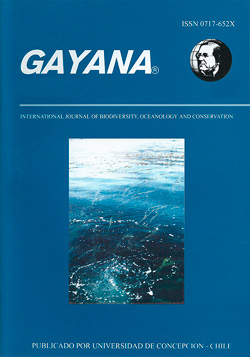Time lapse photography with two different camera systems for in situ observation of the bivalve Diplodon chilensis (Gray, 1828) in a southern Chilean lake
Keywords:
camera system comparison, Diplodon chilensis, exhalant siphon area, time lapse photographyAbstract
We compared the validity of two low cost camera systems to analyze the filtration activity of Diplodon chilensis (Gray, 1828), the most common freshwater bivalve in southern Chile, by using time lapse photography. One camera system (Nikon D300) was connected with an external flash, whereas the other system (GoPro Hero 3+) contained a permanent video light source. Size change of the exhalant siphon area (ESA) of Diplodon individuals was used to track activity changes over time. The siphon of D. chilensis was completely closed for 3.4 % ± 5.2 % (mean ± SD) of the recording time and it shows a nearly completely opened siphon for 42.7 % ± 22.9 % of the recording time. The mean siphon opening was 68.3 % ± 26.5 % of its potential opening area. Although a red filter was placed in front of the video light source, the mobile fauna, especially Aegla abtao (Schmitt, 1942) and unidentified small fishes were highly attracted by the permanent light. We conclude that both low cost cameras are very suitable for in situ time lapse observation of freshwater clams since both deliver good image quality. However, special attention should be given to the light source since permanent light attracts animals including predators which might change filtration activity of D. chilensis.




